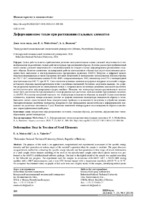| dc.contributor.author | Мойсейчик, Е. А. | |
| dc.contributor.author | Яковлев, А. А. | |
| dc.coverage.spatial | Минск | ru |
| dc.date.accessioned | 2024-10-17T12:55:47Z | |
| dc.date.available | 2024-10-17T12:55:47Z | |
| dc.date.issued | 2024 | |
| dc.identifier.citation | Мойсейчик, Е. А. Деформационное тепло при растяжении стальных элементов = Deformation Heat in Tension of Steel Elements / Е. А. Мойсейчик, А. А. Яковлев // Наука и техника. – 2024. – № 5. – С. 390-396. | ru |
| dc.identifier.uri | https://rep.bntu.by/handle/data/150140 | |
| dc.description.abstract | Целью работы является приближенная расчетно-экспериментальная оценка удельной энергоемкости и теплообразования на различных стадиях работы материала при растяжении образца. В статье рассмотрен приближенный метод оценки удельной энергоемкости и теплообразования на четырех стадиях деформирования растяжением стального образца. Конечно-элементное моделирование работы изготовленного образца при упругопластическом растяжении было выполнено в многофункциональном программном комплексе ANSYS. Нагрузка в цифровой модели образца прикладывалась согласно программе натурных испытаний. В эксперименте использовались плоские образцы по ГОСТ 1497, испытательная машина WAW-1000 с микрокомпьютером 100Т, тепловизор testo 875i с температурной чувствительностью 0,05 °C при 30 °C. Сопоставили полученные значения на графиках натурных испытаний и цифровой модели образцов, выявив критические точки и величины отклонений. Поэтапное загружение выявило, что развитие разрушения происходит на ниспадающих ветвях и сопровождается поэтапным развитием локальной неустойчивости пластического деформирования в форме «шейки». Показано, что температура нагрева растягиваемого металла может быть рассчитана по предлагаемым в статье формулам или расчетом с использованием программного комплекса ANSYS. Результаты испытаний показали, что температуры поверхности образцов на каждой стадии существенно отличаются, выделили четыре основных участка на графике изменения температуры поверхности образца в точке. Выполнен анализ существующей базы измерительных приборов и возможности получения и обработки данных. Экспериментальные величины температур поверхности при непрерывном квазистатическом деформировании превышают их расчетные значения (до 5 раз). Кинетика изменений температурного поля поверхности образца выполнялась термографическими приборами. | ru |
| dc.language.iso | ru | ru |
| dc.publisher | БНТУ | ru |
| dc.title | Деформационное тепло при растяжении стальных элементов | ru |
| dc.title.alternative | Deformation Heat in Tension of Steel Elements | ru |
| dc.type | Article | ru |
| dc.identifier.doi | 10.21122/2227-1031-2024-23-5-390-396 | |
| local.description.annotation | The purpose of the work is an approximate computational and experimental assessment of the specific energy intensity and heat generation at various stages of the material’s operation when the sample is stretched. The paper discusses an approximate method for estimating the specific energy intensity and heat generation at four stages of tensile deformation of a steel sample. Finite element modeling of the work of the manufactured sample under elastic-plastic tension was performed in the ANSYS multifunctional software package. The load in the digital model of the sample was applied according to the full-scale test program. The experiment used flat samples in accordance with GOST 1497, a WAW-1000 testing machine with a 100T microcomputer, and a testo 875i thermal imager with a temperature sensitivity of 0.05 °C at 30 °C. We compared the obtained values on graphs of full-scale tests and a digital model of the samples, identifying critical points and deviation values. Phased loading revealed that the development of destruction occurs on the descending branches and is accompanied by the gradual development of local instability of plastic deformation in the form of a “neck”. It is shown that the heating temperature of the tensile metal can be calculated using the formulas proposed in the paper or by calculation using the ANSYS software package. The test results showed that the surface temperatures of the samples at each stage differ significantly. Four main areas were identified on the graph of changes in the sample surface temperature at a point. An analysis of the existing database of measuring instruments and the ability to obtain and process data was carried out. Experimental values of surface temperatures during continuous quasi-static deformation exceed their calculated values (up to 5 times). The kinetics of changes in the temperature field of the sample surface was carried out using thermographic instruments. | ru |

